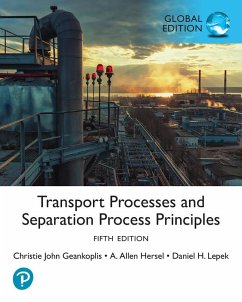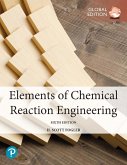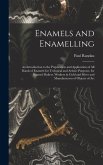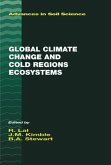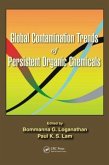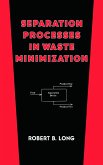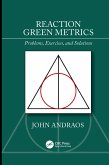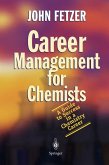Christie Geankoplis, Christie John Geankoplis
Transport Processes and Separation Process Principles, Global Edition
Christie Geankoplis, Christie John Geankoplis
Transport Processes and Separation Process Principles, Global Edition
- Broschiertes Buch
- Merkliste
- Auf die Merkliste
- Bewerten Bewerten
- Teilen
- Produkt teilen
- Produkterinnerung
- Produkterinnerung
Today, chemical engineering students need a thorough understanding of momentum, heat, mass transfer, and separation processes. Transport Processes and Separation Process Principles, 5th Edition offers a unified and up-to-date treatment of all these topics. Thoroughly updated to reflect the field's latest methods and software technologies, it covers both fundamental principles and practical applications.
Andere Kunden interessierten sich auch für
![Elements of Chemical Reaction Engineering, Global Edition Elements of Chemical Reaction Engineering, Global Edition]() H. FoglerElements of Chemical Reaction Engineering, Global Edition79,99 €
H. FoglerElements of Chemical Reaction Engineering, Global Edition79,99 €![Enamels and Enamelling: An Introduction to the Preparation and Application of All Kinds of Enamels for Technical and Artistic Purposes, for En Enamels and Enamelling: An Introduction to the Preparation and Application of All Kinds of Enamels for Technical and Artistic Purposes, for En]() Paul RandauEnamels and Enamelling: An Introduction to the Preparation and Application of All Kinds of Enamels for Technical and Artistic Purposes, for En36,99 €
Paul RandauEnamels and Enamelling: An Introduction to the Preparation and Application of All Kinds of Enamels for Technical and Artistic Purposes, for En36,99 €![Global Climate Change and Cold Regions Ecosystems Global Climate Change and Cold Regions Ecosystems]() John M. Kimble (ed.)Global Climate Change and Cold Regions Ecosystems269,99 €
John M. Kimble (ed.)Global Climate Change and Cold Regions Ecosystems269,99 €![Global Contamination Trends of Persistent Organic Chemicals Global Contamination Trends of Persistent Organic Chemicals]() Global Contamination Trends of Persistent Organic Chemicals305,99 €
Global Contamination Trends of Persistent Organic Chemicals305,99 €![Separation Processes in Waste Minimization Separation Processes in Waste Minimization]() Robert B. LongSeparation Processes in Waste Minimization440,99 €
Robert B. LongSeparation Processes in Waste Minimization440,99 €![Reaction Green Metrics Reaction Green Metrics]() John AndraosReaction Green Metrics265,99 €
John AndraosReaction Green Metrics265,99 €![Career Management for Chemists Career Management for Chemists]() John FetzerCareer Management for Chemists79,99 €
John FetzerCareer Management for Chemists79,99 €-
-
-
Today, chemical engineering students need a thorough understanding of momentum, heat, mass transfer, and separation processes. Transport Processes and Separation Process Principles, 5th Edition offers a unified and up-to-date treatment of all these topics. Thoroughly updated to reflect the field's latest methods and software technologies, it covers both fundamental principles and practical applications.
Hinweis: Dieser Artikel kann nur an eine deutsche Lieferadresse ausgeliefert werden.
Hinweis: Dieser Artikel kann nur an eine deutsche Lieferadresse ausgeliefert werden.
Produktdetails
- Produktdetails
- Verlag: Pearson
- 5. Auflage
- Seitenzahl: 1043
- Erscheinungstermin: 18. September 2024
- Englisch
- Abmessung: 294mm x 216mm x 40mm
- Gewicht: 2124g
- ISBN-13: 9781292445915
- ISBN-10: 1292445912
- Artikelnr.: 65667471
- Herstellerkennzeichnung
- Pearson
- St.-Martin-Straße 82
- 81541 München
- salesde@pearson.com
- +4989541960460
- Verlag: Pearson
- 5. Auflage
- Seitenzahl: 1043
- Erscheinungstermin: 18. September 2024
- Englisch
- Abmessung: 294mm x 216mm x 40mm
- Gewicht: 2124g
- ISBN-13: 9781292445915
- ISBN-10: 1292445912
- Artikelnr.: 65667471
- Herstellerkennzeichnung
- Pearson
- St.-Martin-Straße 82
- 81541 München
- salesde@pearson.com
- +4989541960460
About our authors Christie John Geankoplis was a professor of chemical engineering and materials science at the University of Minnesota. His research interests involved transport processes, biochemical reactor engineering, mass transfer in liquid solutions, and diffusion and/or reaction in porous solids. Allen Hersel is an associate professor in the Department of Chemical Engineering at Trine University in Angola, Indiana, where he teaches transport phenomena and separations for the last 19 years. He also served as the dean of the engineering school. His area of research is bio-separations and engineering education. Before entering academia, he worked for Koch Industries and Kellogg Brown & Root. He holds a Ph.D. in chemical engineering from Yale University. Daniel H. Lepek is a professor at the Department of Chemical Engineering at The Cooper Union. His research interests include particle technology, fluidization and multi-phase flow, pharmaceutical engineering, modeling of transport and bio-transport phenomena, and engineering education. He is an active member of the American Institute of Chemical Engineers (AIChE) and the American Society of Engineering Education (ASEE). He received a Bachelor of Engineering degree in Chemical Engineering from The Cooper Union and received his Ph.D. in Chemical Engineering from New Jersey Institute of Technology (NJIT).
Part 1: Transport Processes: Momentum, Heat, and Mass
1. Introduction to Engineering Principles and Units
o Chapter Objectives
o Classification of Transport Processes and Separation Processes
(Unit Operations)
o SI System of Basic Units Used in This Text and Other Systems
o Methods of Expressing Temperatures and Compositions
o Gas Laws and Vapor Pressure
o Conservation of Mass and Material Balances
o Energy and Heat Units
o Conservation of Energy and Heat Balances
o Numerical Methods for Integration
o Chapter Summary
2. Introduction to Fluids and Fluid Statics
o Chapter Objectives
o Introduction
o Fluid Statics
o Chapter Summary
3. Fluid Properties and Fluid Flows
o Chapter Objectives
o Viscosity of Fluids
o Types of Fluid Flow and Reynolds Number
o Chapter Summary
4. Overall Mass, Energy, and Momentum Balances
o Chapter Objectives
o Overall Mass Balance and Continuity Equation
o Overall Energy Balance
o Overall Momentum Balance
o Shell Momentum Balance and Velocity Profile in Laminar Flow
o Chapter Summary
5. Incompressible and Compressible Flows in Pipes
o Chapter Objectives
o Design Equations for Laminar and Turbulent Flow in Pipes
o Compressible Flow of Gases
o Measuring the Flow of Fluids
o Chapter Summary
6. Flows in Packed and Fluidized Beds
o Chapter Objectives
o Flow Past Immersed Objects
o Flow in Packed Beds
o Flow in Fluidized Beds
o Chapter Summary
7. Pumps, Compressors, and Agitation Equipment
o Chapter Objectives
o Pumps and Gas-Moving Equipment
o Agitation, Mixing of Fluids, and Power Requirements
o Chapter Summary
8. Differential Equations of Fluid Flow
o Chapter Objectives
o Differential Equations of Continuity
o Differential Equations of Momentum Transfer or Motion
o Use of Differential Equations of Continuity and Motion
o Chapter Summary
9. Non-Newtonian Fluids
o Chapter Objectives
o Non-Newtonian Fluids
o Friction Losses for Non-Newtonian Fluids
o Velocity Profiles for Non-Newtonian Fluids
o Determination of Flow Properties of Non-Newtonian Fluids Using
a Rotational Viscometer
o Power Requirements in Agitation and Mixing of Non-Newtonian
Fluids
o Chapter Summary
10. Potential Flow and Creeping Flow
o Chapter Objectives
o Other Methods for Solution of Differential Equations of Motion
o Stream Function
o Differential Equations of Motion for Ideal Fluids (Inviscid
Flow)
o Potential Flow and Velocity Potential
o Differential Equations of Motion for Creeping Flow
o Chapter Summary
11. Boundary-Layer and Turbulent Flow
o Chapter Objectives
o Boundary-Layer Flow
o Turbulent Flow
o Turbulent Boundary-Layer Analysis
o Chapter Summary
12. Introduction to Heat Transfer
o Chapter Objectives
o Energy and Heat Units
o Conservation of Energy and Heat Balances
o Conduction and Thermal Conductivity
o Convection
o Radiation
o Heat Transfer with Multiple Mechanisms/Materials
o Chapter Summary
13. Steady-State Conduction
o Chapter Objectives
o Conduction Heat Transfer
o Conduction Through Solids in Series or Parallel with Convection
o Conduction with Internal Heat Generation
o Steady-State Conduction in Two Dimensions Using Shape Factors
o Numerical Methods for Steady-State Conduction in Two Dimensions
o Chapter Summary
14. Principles of Unsteady-State Heat Transfer
o Chapter Objectives
o Derivation of the Basic Equation
o Simplified Case for Systems with Negligible Internal Resistance
o Unsteady-State Heat Conduction in Various Geometries
o Numerical Finite-Difference Methods for Unsteady-State
Conduction
o Chilling and Freezing of Food and Biological Materials
o Differential Equation of Energy Change
o Chapter Summary
15. Introduction to Convection
o Chapter Objectives
o Introduction and Dimensional Analysis in Heat Transfer
o Boundary-Layer Flow and Turbulence in Heat Transfer
o Forced Convection Heat Transfer Inside Pipes
o Heat Transfer Outside Various Geometries in Forced Convection
o Natural Convection Heat Transfer
o Boiling and Condensation
o Heat Transfer of Non-Newtonian Fluids
o Special Heat-Transfer Coefficients
o Chapter Summary
16. Heat Exchangers
o Chapter Objectives
o Types of Exchangers
o Log-Mean-Temperature-Difference Correction Factors
o Heat-Exchanger Effectiveness
o Fouling Factors and Typical Overall U Values
o Double-Pipe Heat Exchanger
o Chapter Summary
17. Heat Exchangers
o Chapter Objectives
o Types of Exchangers
o Log-Mean-Temperature-Difference Correction Factors
o Heat-Exchanger Effectiveness
o Fouling Factors and Typical Overall U Values
o Double-Pipe Heat Exchanger
o Chapter Summary
18. Introduction to Radiation Heat Transfer
o Chapter Objectives
o Introduction to Radiation Heat-Transfer Concepts
o Basic and Advanced Radiation Heat-Transfer Principles
o Chapter Summary
19. Introduction to Mass Transfer
o Chapter Objectives
o Introduction to Mass Transfer and Diffusion
o Diffusion Coefficient
o Convective Mass Transfer
o Molecular Diffusion Plus Convection and Chemical Reaction
o Chapter Summary
20. Steady-State Mass Transfer
o Chapter Objectives
o Molecular Diffusion in Gases
o Molecular Diffusion in Liquids
o Molecular Diffusion in Solids
o Diffusion of Gases in Porous Solids and Capillaries
o Diffusion in Biological Gels
o Special Cases of the General Diffusion Equation at Steady State
o Numerical Methods for Steady-State Molecular Diffusion in Two
Dimensions
o Chapter Summary
21. Unsteady-State Mass Transfer
o Chapter Objectives
o Unsteady-State Diffusion
o Unsteady-State Diffusion and Reaction in a Semi-Infinite Medium
o Numerical Methods for Unsteady-State Molecular Diffusion
o Chapter Summary
22. Convective Mass Transfer
o Chapter Objectives
o Convective Mass Transfer
o Dimensional Analysis in Mass Transfer
o Mass-Transfer Coefficients for Various Geometries
o Mass Transfer to Suspensions of Small Particles
o Models for Mass-Transfer Coefficients
o Chapter Summary
Part 2: Separation Process Principles
1. Absorption and Stripping
* Chapter Objectives
* Equilibrium and Mass Transfer Between Phases
* Introduction to Absorption
* Pressure Drop and Flooding in Packed Towers
* Design of Plate Absorption Towers
* Design of Packed Towers for Absorption
* Efficiency of Random-Packed and Structured Packed Towers
* Absorption of Concentrated Mixtures in Packed Towers
* Estimation of Mass-Transfer Coefficients for Packed Towers
* Heat Effects and Temperature Variations in Absorption
* Chapter Summary
2. Humidification Processes
* Chapter Objectives
* Vapor Pressure of Water and Humidity
* Introduction and Types of Equipment for Humidification
* Theory and Calculations for Cooling-Water Towers
* Chapter Summary
3. Filtration and Membrane Separation Processes (LiquidLiquid or SolidLiquid
Phase)
* Chapter Objectives
* Introduction to Dead-End Filtration
* Basic Theory of Filtration
* Membrane Separations
* Microfiltration Membrane Processes
* Ultrafiltration Membrane Processes
* Reverse-Osmosis Membrane Processes
* Dialysis
* Chapter Summary
4. Gaseous Membrane Systems
* Chapter Objectives
* Gas Permeation
* Complete-Mixing Model for Gas Separation by Membranes
* Complete-Mixing Model for Multicomponent Mixtures
* Cross-Flow Model for Gas Separation by Membranes
* Derivation of Equations for Countercurrent and Cocurrent Flow for Gas
Separation by Membranes
* Derivation of Finite-Difference Numerical Method for Asymmetric
Membranes
* Chapter Summary
5. Distillation
* Chapter Objectives
* Equilibrium Relations Between Phases
* Single and Multiple Equilibrium Contact Stages
* Simple Distillation Methods
* Binary Distillation with Reflux Using the McCabeThiele and Lewis
Methods
* Tray Efficiencies
* Flooding Velocity and Diameter of Tray Towers Plus Simple
Calculations for Reboiler and Condenser Duties
* Fractional Distillation Using the EnthalpyConcentration Method
* Distillation of Multicomponent Mixtures
* Chapter Summary
6. LiquidLiquid Extraction
* Chapter Objectives
* Introduction to LiquidLiquid Extraction
* Single-Stage Equilibrium Extraction
* Types of Equipment and Design for LiquidLiquid Extraction
* Continuous Multistage Countercurrent Extraction
* Chapter Summary
7. Adsorption and Ion Exchange
* Chapter Objectives
* Introduction to Adsorption Processes
* Batch Adsorption
* Design of Fixed-Bed Adsorption Columns
* Ion-Exchange Processes
* Chapter Summary
8. Crystallization and Particle Size Reduction
* Chapter Objectives
* Introduction to Crystallization
* Crystallization Theory
* Mechanical Size Reduction
* Chapter Summary
9. Settling, Sedimentation, and Centrifugation
* Chapter Objectives
* Settling and Sedimentation in ParticleFluid Separation
* Centrifugal Separation Processes
* Chapter Summary
10. Leaching
* Chapter Objectives
* Introduction and Equipment for LiquidSolid Leaching
* Equilibrium Relations and Single-Stage Leaching
* Countercurrent Multistage Leaching
* Chapter Summary
11. Evaporation
* Chapter Objectives
* Introduction
* Types of Evaporation Equipment and Operation Methods
* Overall Heat-Transfer Coefficients in Evaporators
* Calculation Methods for Single-Effect Evaporators
* Calculation Methods for Multiple-Effect Evaporators
* Condensers for Evaporators
* Evaporation of Biological Materials
* Evaporation Using Vapor Recompression
* Chapter Summary
12. Drying
* Chapter Objectives
* Introduction and Methods of Drying
* Equipment for Drying
* Vapor Pressure of Water and Humidity
* Equilibrium Moisture Content of Materials
* Rate-of-Drying Curves
* Calculation Methods for a Constant-Rate Drying Period
* Calculation Methods for the Falling-Rate Drying Period
* Combined Convection, Radiation, and Conduction Heat Transfer in the
Constant-Rate Period
* Drying in the Falling-Rate Period by Diffusion and Capillary Flow
* Equations for Various Types of Dryers
* Freeze-Drying of Biological Materials
* Unsteady-State Thermal Processing and Sterilization of Biological
Materials
* Chapter Summary
Part 3: Appendixes
* Appendix A.1 Fundamental Constants and Conversion Factors
* Appendix A.2 Physical Properties of Water
* Appendix A.3 Physical Properties of Inorganic and Organic Compounds
* Appendix A.4 Physical Properties of Foods and Biological Materials
* Appendix A.5 Properties of Pipes, Tubes, and Screens
* Appendix A.6 Lennard-Jones Potentials as Determined from Viscosity
Data
* Notation
* Index
1. Introduction to Engineering Principles and Units
o Chapter Objectives
o Classification of Transport Processes and Separation Processes
(Unit Operations)
o SI System of Basic Units Used in This Text and Other Systems
o Methods of Expressing Temperatures and Compositions
o Gas Laws and Vapor Pressure
o Conservation of Mass and Material Balances
o Energy and Heat Units
o Conservation of Energy and Heat Balances
o Numerical Methods for Integration
o Chapter Summary
2. Introduction to Fluids and Fluid Statics
o Chapter Objectives
o Introduction
o Fluid Statics
o Chapter Summary
3. Fluid Properties and Fluid Flows
o Chapter Objectives
o Viscosity of Fluids
o Types of Fluid Flow and Reynolds Number
o Chapter Summary
4. Overall Mass, Energy, and Momentum Balances
o Chapter Objectives
o Overall Mass Balance and Continuity Equation
o Overall Energy Balance
o Overall Momentum Balance
o Shell Momentum Balance and Velocity Profile in Laminar Flow
o Chapter Summary
5. Incompressible and Compressible Flows in Pipes
o Chapter Objectives
o Design Equations for Laminar and Turbulent Flow in Pipes
o Compressible Flow of Gases
o Measuring the Flow of Fluids
o Chapter Summary
6. Flows in Packed and Fluidized Beds
o Chapter Objectives
o Flow Past Immersed Objects
o Flow in Packed Beds
o Flow in Fluidized Beds
o Chapter Summary
7. Pumps, Compressors, and Agitation Equipment
o Chapter Objectives
o Pumps and Gas-Moving Equipment
o Agitation, Mixing of Fluids, and Power Requirements
o Chapter Summary
8. Differential Equations of Fluid Flow
o Chapter Objectives
o Differential Equations of Continuity
o Differential Equations of Momentum Transfer or Motion
o Use of Differential Equations of Continuity and Motion
o Chapter Summary
9. Non-Newtonian Fluids
o Chapter Objectives
o Non-Newtonian Fluids
o Friction Losses for Non-Newtonian Fluids
o Velocity Profiles for Non-Newtonian Fluids
o Determination of Flow Properties of Non-Newtonian Fluids Using
a Rotational Viscometer
o Power Requirements in Agitation and Mixing of Non-Newtonian
Fluids
o Chapter Summary
10. Potential Flow and Creeping Flow
o Chapter Objectives
o Other Methods for Solution of Differential Equations of Motion
o Stream Function
o Differential Equations of Motion for Ideal Fluids (Inviscid
Flow)
o Potential Flow and Velocity Potential
o Differential Equations of Motion for Creeping Flow
o Chapter Summary
11. Boundary-Layer and Turbulent Flow
o Chapter Objectives
o Boundary-Layer Flow
o Turbulent Flow
o Turbulent Boundary-Layer Analysis
o Chapter Summary
12. Introduction to Heat Transfer
o Chapter Objectives
o Energy and Heat Units
o Conservation of Energy and Heat Balances
o Conduction and Thermal Conductivity
o Convection
o Radiation
o Heat Transfer with Multiple Mechanisms/Materials
o Chapter Summary
13. Steady-State Conduction
o Chapter Objectives
o Conduction Heat Transfer
o Conduction Through Solids in Series or Parallel with Convection
o Conduction with Internal Heat Generation
o Steady-State Conduction in Two Dimensions Using Shape Factors
o Numerical Methods for Steady-State Conduction in Two Dimensions
o Chapter Summary
14. Principles of Unsteady-State Heat Transfer
o Chapter Objectives
o Derivation of the Basic Equation
o Simplified Case for Systems with Negligible Internal Resistance
o Unsteady-State Heat Conduction in Various Geometries
o Numerical Finite-Difference Methods for Unsteady-State
Conduction
o Chilling and Freezing of Food and Biological Materials
o Differential Equation of Energy Change
o Chapter Summary
15. Introduction to Convection
o Chapter Objectives
o Introduction and Dimensional Analysis in Heat Transfer
o Boundary-Layer Flow and Turbulence in Heat Transfer
o Forced Convection Heat Transfer Inside Pipes
o Heat Transfer Outside Various Geometries in Forced Convection
o Natural Convection Heat Transfer
o Boiling and Condensation
o Heat Transfer of Non-Newtonian Fluids
o Special Heat-Transfer Coefficients
o Chapter Summary
16. Heat Exchangers
o Chapter Objectives
o Types of Exchangers
o Log-Mean-Temperature-Difference Correction Factors
o Heat-Exchanger Effectiveness
o Fouling Factors and Typical Overall U Values
o Double-Pipe Heat Exchanger
o Chapter Summary
17. Heat Exchangers
o Chapter Objectives
o Types of Exchangers
o Log-Mean-Temperature-Difference Correction Factors
o Heat-Exchanger Effectiveness
o Fouling Factors and Typical Overall U Values
o Double-Pipe Heat Exchanger
o Chapter Summary
18. Introduction to Radiation Heat Transfer
o Chapter Objectives
o Introduction to Radiation Heat-Transfer Concepts
o Basic and Advanced Radiation Heat-Transfer Principles
o Chapter Summary
19. Introduction to Mass Transfer
o Chapter Objectives
o Introduction to Mass Transfer and Diffusion
o Diffusion Coefficient
o Convective Mass Transfer
o Molecular Diffusion Plus Convection and Chemical Reaction
o Chapter Summary
20. Steady-State Mass Transfer
o Chapter Objectives
o Molecular Diffusion in Gases
o Molecular Diffusion in Liquids
o Molecular Diffusion in Solids
o Diffusion of Gases in Porous Solids and Capillaries
o Diffusion in Biological Gels
o Special Cases of the General Diffusion Equation at Steady State
o Numerical Methods for Steady-State Molecular Diffusion in Two
Dimensions
o Chapter Summary
21. Unsteady-State Mass Transfer
o Chapter Objectives
o Unsteady-State Diffusion
o Unsteady-State Diffusion and Reaction in a Semi-Infinite Medium
o Numerical Methods for Unsteady-State Molecular Diffusion
o Chapter Summary
22. Convective Mass Transfer
o Chapter Objectives
o Convective Mass Transfer
o Dimensional Analysis in Mass Transfer
o Mass-Transfer Coefficients for Various Geometries
o Mass Transfer to Suspensions of Small Particles
o Models for Mass-Transfer Coefficients
o Chapter Summary
Part 2: Separation Process Principles
1. Absorption and Stripping
* Chapter Objectives
* Equilibrium and Mass Transfer Between Phases
* Introduction to Absorption
* Pressure Drop and Flooding in Packed Towers
* Design of Plate Absorption Towers
* Design of Packed Towers for Absorption
* Efficiency of Random-Packed and Structured Packed Towers
* Absorption of Concentrated Mixtures in Packed Towers
* Estimation of Mass-Transfer Coefficients for Packed Towers
* Heat Effects and Temperature Variations in Absorption
* Chapter Summary
2. Humidification Processes
* Chapter Objectives
* Vapor Pressure of Water and Humidity
* Introduction and Types of Equipment for Humidification
* Theory and Calculations for Cooling-Water Towers
* Chapter Summary
3. Filtration and Membrane Separation Processes (LiquidLiquid or SolidLiquid
Phase)
* Chapter Objectives
* Introduction to Dead-End Filtration
* Basic Theory of Filtration
* Membrane Separations
* Microfiltration Membrane Processes
* Ultrafiltration Membrane Processes
* Reverse-Osmosis Membrane Processes
* Dialysis
* Chapter Summary
4. Gaseous Membrane Systems
* Chapter Objectives
* Gas Permeation
* Complete-Mixing Model for Gas Separation by Membranes
* Complete-Mixing Model for Multicomponent Mixtures
* Cross-Flow Model for Gas Separation by Membranes
* Derivation of Equations for Countercurrent and Cocurrent Flow for Gas
Separation by Membranes
* Derivation of Finite-Difference Numerical Method for Asymmetric
Membranes
* Chapter Summary
5. Distillation
* Chapter Objectives
* Equilibrium Relations Between Phases
* Single and Multiple Equilibrium Contact Stages
* Simple Distillation Methods
* Binary Distillation with Reflux Using the McCabeThiele and Lewis
Methods
* Tray Efficiencies
* Flooding Velocity and Diameter of Tray Towers Plus Simple
Calculations for Reboiler and Condenser Duties
* Fractional Distillation Using the EnthalpyConcentration Method
* Distillation of Multicomponent Mixtures
* Chapter Summary
6. LiquidLiquid Extraction
* Chapter Objectives
* Introduction to LiquidLiquid Extraction
* Single-Stage Equilibrium Extraction
* Types of Equipment and Design for LiquidLiquid Extraction
* Continuous Multistage Countercurrent Extraction
* Chapter Summary
7. Adsorption and Ion Exchange
* Chapter Objectives
* Introduction to Adsorption Processes
* Batch Adsorption
* Design of Fixed-Bed Adsorption Columns
* Ion-Exchange Processes
* Chapter Summary
8. Crystallization and Particle Size Reduction
* Chapter Objectives
* Introduction to Crystallization
* Crystallization Theory
* Mechanical Size Reduction
* Chapter Summary
9. Settling, Sedimentation, and Centrifugation
* Chapter Objectives
* Settling and Sedimentation in ParticleFluid Separation
* Centrifugal Separation Processes
* Chapter Summary
10. Leaching
* Chapter Objectives
* Introduction and Equipment for LiquidSolid Leaching
* Equilibrium Relations and Single-Stage Leaching
* Countercurrent Multistage Leaching
* Chapter Summary
11. Evaporation
* Chapter Objectives
* Introduction
* Types of Evaporation Equipment and Operation Methods
* Overall Heat-Transfer Coefficients in Evaporators
* Calculation Methods for Single-Effect Evaporators
* Calculation Methods for Multiple-Effect Evaporators
* Condensers for Evaporators
* Evaporation of Biological Materials
* Evaporation Using Vapor Recompression
* Chapter Summary
12. Drying
* Chapter Objectives
* Introduction and Methods of Drying
* Equipment for Drying
* Vapor Pressure of Water and Humidity
* Equilibrium Moisture Content of Materials
* Rate-of-Drying Curves
* Calculation Methods for a Constant-Rate Drying Period
* Calculation Methods for the Falling-Rate Drying Period
* Combined Convection, Radiation, and Conduction Heat Transfer in the
Constant-Rate Period
* Drying in the Falling-Rate Period by Diffusion and Capillary Flow
* Equations for Various Types of Dryers
* Freeze-Drying of Biological Materials
* Unsteady-State Thermal Processing and Sterilization of Biological
Materials
* Chapter Summary
Part 3: Appendixes
* Appendix A.1 Fundamental Constants and Conversion Factors
* Appendix A.2 Physical Properties of Water
* Appendix A.3 Physical Properties of Inorganic and Organic Compounds
* Appendix A.4 Physical Properties of Foods and Biological Materials
* Appendix A.5 Properties of Pipes, Tubes, and Screens
* Appendix A.6 Lennard-Jones Potentials as Determined from Viscosity
Data
* Notation
* Index
Part 1: Transport Processes: Momentum, Heat, and Mass
1. Introduction to Engineering Principles and Units
o Chapter Objectives
o Classification of Transport Processes and Separation Processes
(Unit Operations)
o SI System of Basic Units Used in This Text and Other Systems
o Methods of Expressing Temperatures and Compositions
o Gas Laws and Vapor Pressure
o Conservation of Mass and Material Balances
o Energy and Heat Units
o Conservation of Energy and Heat Balances
o Numerical Methods for Integration
o Chapter Summary
2. Introduction to Fluids and Fluid Statics
o Chapter Objectives
o Introduction
o Fluid Statics
o Chapter Summary
3. Fluid Properties and Fluid Flows
o Chapter Objectives
o Viscosity of Fluids
o Types of Fluid Flow and Reynolds Number
o Chapter Summary
4. Overall Mass, Energy, and Momentum Balances
o Chapter Objectives
o Overall Mass Balance and Continuity Equation
o Overall Energy Balance
o Overall Momentum Balance
o Shell Momentum Balance and Velocity Profile in Laminar Flow
o Chapter Summary
5. Incompressible and Compressible Flows in Pipes
o Chapter Objectives
o Design Equations for Laminar and Turbulent Flow in Pipes
o Compressible Flow of Gases
o Measuring the Flow of Fluids
o Chapter Summary
6. Flows in Packed and Fluidized Beds
o Chapter Objectives
o Flow Past Immersed Objects
o Flow in Packed Beds
o Flow in Fluidized Beds
o Chapter Summary
7. Pumps, Compressors, and Agitation Equipment
o Chapter Objectives
o Pumps and Gas-Moving Equipment
o Agitation, Mixing of Fluids, and Power Requirements
o Chapter Summary
8. Differential Equations of Fluid Flow
o Chapter Objectives
o Differential Equations of Continuity
o Differential Equations of Momentum Transfer or Motion
o Use of Differential Equations of Continuity and Motion
o Chapter Summary
9. Non-Newtonian Fluids
o Chapter Objectives
o Non-Newtonian Fluids
o Friction Losses for Non-Newtonian Fluids
o Velocity Profiles for Non-Newtonian Fluids
o Determination of Flow Properties of Non-Newtonian Fluids Using
a Rotational Viscometer
o Power Requirements in Agitation and Mixing of Non-Newtonian
Fluids
o Chapter Summary
10. Potential Flow and Creeping Flow
o Chapter Objectives
o Other Methods for Solution of Differential Equations of Motion
o Stream Function
o Differential Equations of Motion for Ideal Fluids (Inviscid
Flow)
o Potential Flow and Velocity Potential
o Differential Equations of Motion for Creeping Flow
o Chapter Summary
11. Boundary-Layer and Turbulent Flow
o Chapter Objectives
o Boundary-Layer Flow
o Turbulent Flow
o Turbulent Boundary-Layer Analysis
o Chapter Summary
12. Introduction to Heat Transfer
o Chapter Objectives
o Energy and Heat Units
o Conservation of Energy and Heat Balances
o Conduction and Thermal Conductivity
o Convection
o Radiation
o Heat Transfer with Multiple Mechanisms/Materials
o Chapter Summary
13. Steady-State Conduction
o Chapter Objectives
o Conduction Heat Transfer
o Conduction Through Solids in Series or Parallel with Convection
o Conduction with Internal Heat Generation
o Steady-State Conduction in Two Dimensions Using Shape Factors
o Numerical Methods for Steady-State Conduction in Two Dimensions
o Chapter Summary
14. Principles of Unsteady-State Heat Transfer
o Chapter Objectives
o Derivation of the Basic Equation
o Simplified Case for Systems with Negligible Internal Resistance
o Unsteady-State Heat Conduction in Various Geometries
o Numerical Finite-Difference Methods for Unsteady-State
Conduction
o Chilling and Freezing of Food and Biological Materials
o Differential Equation of Energy Change
o Chapter Summary
15. Introduction to Convection
o Chapter Objectives
o Introduction and Dimensional Analysis in Heat Transfer
o Boundary-Layer Flow and Turbulence in Heat Transfer
o Forced Convection Heat Transfer Inside Pipes
o Heat Transfer Outside Various Geometries in Forced Convection
o Natural Convection Heat Transfer
o Boiling and Condensation
o Heat Transfer of Non-Newtonian Fluids
o Special Heat-Transfer Coefficients
o Chapter Summary
16. Heat Exchangers
o Chapter Objectives
o Types of Exchangers
o Log-Mean-Temperature-Difference Correction Factors
o Heat-Exchanger Effectiveness
o Fouling Factors and Typical Overall U Values
o Double-Pipe Heat Exchanger
o Chapter Summary
17. Heat Exchangers
o Chapter Objectives
o Types of Exchangers
o Log-Mean-Temperature-Difference Correction Factors
o Heat-Exchanger Effectiveness
o Fouling Factors and Typical Overall U Values
o Double-Pipe Heat Exchanger
o Chapter Summary
18. Introduction to Radiation Heat Transfer
o Chapter Objectives
o Introduction to Radiation Heat-Transfer Concepts
o Basic and Advanced Radiation Heat-Transfer Principles
o Chapter Summary
19. Introduction to Mass Transfer
o Chapter Objectives
o Introduction to Mass Transfer and Diffusion
o Diffusion Coefficient
o Convective Mass Transfer
o Molecular Diffusion Plus Convection and Chemical Reaction
o Chapter Summary
20. Steady-State Mass Transfer
o Chapter Objectives
o Molecular Diffusion in Gases
o Molecular Diffusion in Liquids
o Molecular Diffusion in Solids
o Diffusion of Gases in Porous Solids and Capillaries
o Diffusion in Biological Gels
o Special Cases of the General Diffusion Equation at Steady State
o Numerical Methods for Steady-State Molecular Diffusion in Two
Dimensions
o Chapter Summary
21. Unsteady-State Mass Transfer
o Chapter Objectives
o Unsteady-State Diffusion
o Unsteady-State Diffusion and Reaction in a Semi-Infinite Medium
o Numerical Methods for Unsteady-State Molecular Diffusion
o Chapter Summary
22. Convective Mass Transfer
o Chapter Objectives
o Convective Mass Transfer
o Dimensional Analysis in Mass Transfer
o Mass-Transfer Coefficients for Various Geometries
o Mass Transfer to Suspensions of Small Particles
o Models for Mass-Transfer Coefficients
o Chapter Summary
Part 2: Separation Process Principles
1. Absorption and Stripping
* Chapter Objectives
* Equilibrium and Mass Transfer Between Phases
* Introduction to Absorption
* Pressure Drop and Flooding in Packed Towers
* Design of Plate Absorption Towers
* Design of Packed Towers for Absorption
* Efficiency of Random-Packed and Structured Packed Towers
* Absorption of Concentrated Mixtures in Packed Towers
* Estimation of Mass-Transfer Coefficients for Packed Towers
* Heat Effects and Temperature Variations in Absorption
* Chapter Summary
2. Humidification Processes
* Chapter Objectives
* Vapor Pressure of Water and Humidity
* Introduction and Types of Equipment for Humidification
* Theory and Calculations for Cooling-Water Towers
* Chapter Summary
3. Filtration and Membrane Separation Processes (LiquidLiquid or SolidLiquid
Phase)
* Chapter Objectives
* Introduction to Dead-End Filtration
* Basic Theory of Filtration
* Membrane Separations
* Microfiltration Membrane Processes
* Ultrafiltration Membrane Processes
* Reverse-Osmosis Membrane Processes
* Dialysis
* Chapter Summary
4. Gaseous Membrane Systems
* Chapter Objectives
* Gas Permeation
* Complete-Mixing Model for Gas Separation by Membranes
* Complete-Mixing Model for Multicomponent Mixtures
* Cross-Flow Model for Gas Separation by Membranes
* Derivation of Equations for Countercurrent and Cocurrent Flow for Gas
Separation by Membranes
* Derivation of Finite-Difference Numerical Method for Asymmetric
Membranes
* Chapter Summary
5. Distillation
* Chapter Objectives
* Equilibrium Relations Between Phases
* Single and Multiple Equilibrium Contact Stages
* Simple Distillation Methods
* Binary Distillation with Reflux Using the McCabeThiele and Lewis
Methods
* Tray Efficiencies
* Flooding Velocity and Diameter of Tray Towers Plus Simple
Calculations for Reboiler and Condenser Duties
* Fractional Distillation Using the EnthalpyConcentration Method
* Distillation of Multicomponent Mixtures
* Chapter Summary
6. LiquidLiquid Extraction
* Chapter Objectives
* Introduction to LiquidLiquid Extraction
* Single-Stage Equilibrium Extraction
* Types of Equipment and Design for LiquidLiquid Extraction
* Continuous Multistage Countercurrent Extraction
* Chapter Summary
7. Adsorption and Ion Exchange
* Chapter Objectives
* Introduction to Adsorption Processes
* Batch Adsorption
* Design of Fixed-Bed Adsorption Columns
* Ion-Exchange Processes
* Chapter Summary
8. Crystallization and Particle Size Reduction
* Chapter Objectives
* Introduction to Crystallization
* Crystallization Theory
* Mechanical Size Reduction
* Chapter Summary
9. Settling, Sedimentation, and Centrifugation
* Chapter Objectives
* Settling and Sedimentation in ParticleFluid Separation
* Centrifugal Separation Processes
* Chapter Summary
10. Leaching
* Chapter Objectives
* Introduction and Equipment for LiquidSolid Leaching
* Equilibrium Relations and Single-Stage Leaching
* Countercurrent Multistage Leaching
* Chapter Summary
11. Evaporation
* Chapter Objectives
* Introduction
* Types of Evaporation Equipment and Operation Methods
* Overall Heat-Transfer Coefficients in Evaporators
* Calculation Methods for Single-Effect Evaporators
* Calculation Methods for Multiple-Effect Evaporators
* Condensers for Evaporators
* Evaporation of Biological Materials
* Evaporation Using Vapor Recompression
* Chapter Summary
12. Drying
* Chapter Objectives
* Introduction and Methods of Drying
* Equipment for Drying
* Vapor Pressure of Water and Humidity
* Equilibrium Moisture Content of Materials
* Rate-of-Drying Curves
* Calculation Methods for a Constant-Rate Drying Period
* Calculation Methods for the Falling-Rate Drying Period
* Combined Convection, Radiation, and Conduction Heat Transfer in the
Constant-Rate Period
* Drying in the Falling-Rate Period by Diffusion and Capillary Flow
* Equations for Various Types of Dryers
* Freeze-Drying of Biological Materials
* Unsteady-State Thermal Processing and Sterilization of Biological
Materials
* Chapter Summary
Part 3: Appendixes
* Appendix A.1 Fundamental Constants and Conversion Factors
* Appendix A.2 Physical Properties of Water
* Appendix A.3 Physical Properties of Inorganic and Organic Compounds
* Appendix A.4 Physical Properties of Foods and Biological Materials
* Appendix A.5 Properties of Pipes, Tubes, and Screens
* Appendix A.6 Lennard-Jones Potentials as Determined from Viscosity
Data
* Notation
* Index
1. Introduction to Engineering Principles and Units
o Chapter Objectives
o Classification of Transport Processes and Separation Processes
(Unit Operations)
o SI System of Basic Units Used in This Text and Other Systems
o Methods of Expressing Temperatures and Compositions
o Gas Laws and Vapor Pressure
o Conservation of Mass and Material Balances
o Energy and Heat Units
o Conservation of Energy and Heat Balances
o Numerical Methods for Integration
o Chapter Summary
2. Introduction to Fluids and Fluid Statics
o Chapter Objectives
o Introduction
o Fluid Statics
o Chapter Summary
3. Fluid Properties and Fluid Flows
o Chapter Objectives
o Viscosity of Fluids
o Types of Fluid Flow and Reynolds Number
o Chapter Summary
4. Overall Mass, Energy, and Momentum Balances
o Chapter Objectives
o Overall Mass Balance and Continuity Equation
o Overall Energy Balance
o Overall Momentum Balance
o Shell Momentum Balance and Velocity Profile in Laminar Flow
o Chapter Summary
5. Incompressible and Compressible Flows in Pipes
o Chapter Objectives
o Design Equations for Laminar and Turbulent Flow in Pipes
o Compressible Flow of Gases
o Measuring the Flow of Fluids
o Chapter Summary
6. Flows in Packed and Fluidized Beds
o Chapter Objectives
o Flow Past Immersed Objects
o Flow in Packed Beds
o Flow in Fluidized Beds
o Chapter Summary
7. Pumps, Compressors, and Agitation Equipment
o Chapter Objectives
o Pumps and Gas-Moving Equipment
o Agitation, Mixing of Fluids, and Power Requirements
o Chapter Summary
8. Differential Equations of Fluid Flow
o Chapter Objectives
o Differential Equations of Continuity
o Differential Equations of Momentum Transfer or Motion
o Use of Differential Equations of Continuity and Motion
o Chapter Summary
9. Non-Newtonian Fluids
o Chapter Objectives
o Non-Newtonian Fluids
o Friction Losses for Non-Newtonian Fluids
o Velocity Profiles for Non-Newtonian Fluids
o Determination of Flow Properties of Non-Newtonian Fluids Using
a Rotational Viscometer
o Power Requirements in Agitation and Mixing of Non-Newtonian
Fluids
o Chapter Summary
10. Potential Flow and Creeping Flow
o Chapter Objectives
o Other Methods for Solution of Differential Equations of Motion
o Stream Function
o Differential Equations of Motion for Ideal Fluids (Inviscid
Flow)
o Potential Flow and Velocity Potential
o Differential Equations of Motion for Creeping Flow
o Chapter Summary
11. Boundary-Layer and Turbulent Flow
o Chapter Objectives
o Boundary-Layer Flow
o Turbulent Flow
o Turbulent Boundary-Layer Analysis
o Chapter Summary
12. Introduction to Heat Transfer
o Chapter Objectives
o Energy and Heat Units
o Conservation of Energy and Heat Balances
o Conduction and Thermal Conductivity
o Convection
o Radiation
o Heat Transfer with Multiple Mechanisms/Materials
o Chapter Summary
13. Steady-State Conduction
o Chapter Objectives
o Conduction Heat Transfer
o Conduction Through Solids in Series or Parallel with Convection
o Conduction with Internal Heat Generation
o Steady-State Conduction in Two Dimensions Using Shape Factors
o Numerical Methods for Steady-State Conduction in Two Dimensions
o Chapter Summary
14. Principles of Unsteady-State Heat Transfer
o Chapter Objectives
o Derivation of the Basic Equation
o Simplified Case for Systems with Negligible Internal Resistance
o Unsteady-State Heat Conduction in Various Geometries
o Numerical Finite-Difference Methods for Unsteady-State
Conduction
o Chilling and Freezing of Food and Biological Materials
o Differential Equation of Energy Change
o Chapter Summary
15. Introduction to Convection
o Chapter Objectives
o Introduction and Dimensional Analysis in Heat Transfer
o Boundary-Layer Flow and Turbulence in Heat Transfer
o Forced Convection Heat Transfer Inside Pipes
o Heat Transfer Outside Various Geometries in Forced Convection
o Natural Convection Heat Transfer
o Boiling and Condensation
o Heat Transfer of Non-Newtonian Fluids
o Special Heat-Transfer Coefficients
o Chapter Summary
16. Heat Exchangers
o Chapter Objectives
o Types of Exchangers
o Log-Mean-Temperature-Difference Correction Factors
o Heat-Exchanger Effectiveness
o Fouling Factors and Typical Overall U Values
o Double-Pipe Heat Exchanger
o Chapter Summary
17. Heat Exchangers
o Chapter Objectives
o Types of Exchangers
o Log-Mean-Temperature-Difference Correction Factors
o Heat-Exchanger Effectiveness
o Fouling Factors and Typical Overall U Values
o Double-Pipe Heat Exchanger
o Chapter Summary
18. Introduction to Radiation Heat Transfer
o Chapter Objectives
o Introduction to Radiation Heat-Transfer Concepts
o Basic and Advanced Radiation Heat-Transfer Principles
o Chapter Summary
19. Introduction to Mass Transfer
o Chapter Objectives
o Introduction to Mass Transfer and Diffusion
o Diffusion Coefficient
o Convective Mass Transfer
o Molecular Diffusion Plus Convection and Chemical Reaction
o Chapter Summary
20. Steady-State Mass Transfer
o Chapter Objectives
o Molecular Diffusion in Gases
o Molecular Diffusion in Liquids
o Molecular Diffusion in Solids
o Diffusion of Gases in Porous Solids and Capillaries
o Diffusion in Biological Gels
o Special Cases of the General Diffusion Equation at Steady State
o Numerical Methods for Steady-State Molecular Diffusion in Two
Dimensions
o Chapter Summary
21. Unsteady-State Mass Transfer
o Chapter Objectives
o Unsteady-State Diffusion
o Unsteady-State Diffusion and Reaction in a Semi-Infinite Medium
o Numerical Methods for Unsteady-State Molecular Diffusion
o Chapter Summary
22. Convective Mass Transfer
o Chapter Objectives
o Convective Mass Transfer
o Dimensional Analysis in Mass Transfer
o Mass-Transfer Coefficients for Various Geometries
o Mass Transfer to Suspensions of Small Particles
o Models for Mass-Transfer Coefficients
o Chapter Summary
Part 2: Separation Process Principles
1. Absorption and Stripping
* Chapter Objectives
* Equilibrium and Mass Transfer Between Phases
* Introduction to Absorption
* Pressure Drop and Flooding in Packed Towers
* Design of Plate Absorption Towers
* Design of Packed Towers for Absorption
* Efficiency of Random-Packed and Structured Packed Towers
* Absorption of Concentrated Mixtures in Packed Towers
* Estimation of Mass-Transfer Coefficients for Packed Towers
* Heat Effects and Temperature Variations in Absorption
* Chapter Summary
2. Humidification Processes
* Chapter Objectives
* Vapor Pressure of Water and Humidity
* Introduction and Types of Equipment for Humidification
* Theory and Calculations for Cooling-Water Towers
* Chapter Summary
3. Filtration and Membrane Separation Processes (LiquidLiquid or SolidLiquid
Phase)
* Chapter Objectives
* Introduction to Dead-End Filtration
* Basic Theory of Filtration
* Membrane Separations
* Microfiltration Membrane Processes
* Ultrafiltration Membrane Processes
* Reverse-Osmosis Membrane Processes
* Dialysis
* Chapter Summary
4. Gaseous Membrane Systems
* Chapter Objectives
* Gas Permeation
* Complete-Mixing Model for Gas Separation by Membranes
* Complete-Mixing Model for Multicomponent Mixtures
* Cross-Flow Model for Gas Separation by Membranes
* Derivation of Equations for Countercurrent and Cocurrent Flow for Gas
Separation by Membranes
* Derivation of Finite-Difference Numerical Method for Asymmetric
Membranes
* Chapter Summary
5. Distillation
* Chapter Objectives
* Equilibrium Relations Between Phases
* Single and Multiple Equilibrium Contact Stages
* Simple Distillation Methods
* Binary Distillation with Reflux Using the McCabeThiele and Lewis
Methods
* Tray Efficiencies
* Flooding Velocity and Diameter of Tray Towers Plus Simple
Calculations for Reboiler and Condenser Duties
* Fractional Distillation Using the EnthalpyConcentration Method
* Distillation of Multicomponent Mixtures
* Chapter Summary
6. LiquidLiquid Extraction
* Chapter Objectives
* Introduction to LiquidLiquid Extraction
* Single-Stage Equilibrium Extraction
* Types of Equipment and Design for LiquidLiquid Extraction
* Continuous Multistage Countercurrent Extraction
* Chapter Summary
7. Adsorption and Ion Exchange
* Chapter Objectives
* Introduction to Adsorption Processes
* Batch Adsorption
* Design of Fixed-Bed Adsorption Columns
* Ion-Exchange Processes
* Chapter Summary
8. Crystallization and Particle Size Reduction
* Chapter Objectives
* Introduction to Crystallization
* Crystallization Theory
* Mechanical Size Reduction
* Chapter Summary
9. Settling, Sedimentation, and Centrifugation
* Chapter Objectives
* Settling and Sedimentation in ParticleFluid Separation
* Centrifugal Separation Processes
* Chapter Summary
10. Leaching
* Chapter Objectives
* Introduction and Equipment for LiquidSolid Leaching
* Equilibrium Relations and Single-Stage Leaching
* Countercurrent Multistage Leaching
* Chapter Summary
11. Evaporation
* Chapter Objectives
* Introduction
* Types of Evaporation Equipment and Operation Methods
* Overall Heat-Transfer Coefficients in Evaporators
* Calculation Methods for Single-Effect Evaporators
* Calculation Methods for Multiple-Effect Evaporators
* Condensers for Evaporators
* Evaporation of Biological Materials
* Evaporation Using Vapor Recompression
* Chapter Summary
12. Drying
* Chapter Objectives
* Introduction and Methods of Drying
* Equipment for Drying
* Vapor Pressure of Water and Humidity
* Equilibrium Moisture Content of Materials
* Rate-of-Drying Curves
* Calculation Methods for a Constant-Rate Drying Period
* Calculation Methods for the Falling-Rate Drying Period
* Combined Convection, Radiation, and Conduction Heat Transfer in the
Constant-Rate Period
* Drying in the Falling-Rate Period by Diffusion and Capillary Flow
* Equations for Various Types of Dryers
* Freeze-Drying of Biological Materials
* Unsteady-State Thermal Processing and Sterilization of Biological
Materials
* Chapter Summary
Part 3: Appendixes
* Appendix A.1 Fundamental Constants and Conversion Factors
* Appendix A.2 Physical Properties of Water
* Appendix A.3 Physical Properties of Inorganic and Organic Compounds
* Appendix A.4 Physical Properties of Foods and Biological Materials
* Appendix A.5 Properties of Pipes, Tubes, and Screens
* Appendix A.6 Lennard-Jones Potentials as Determined from Viscosity
Data
* Notation
* Index

